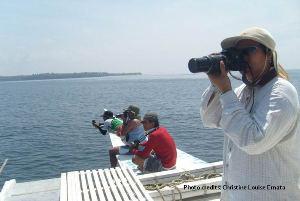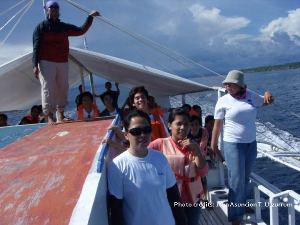Edna Sabater
Other projects
This project aims to estimate the population size, address movement patterns and habitat range of the most frequently sighted cetaceans in the NW Mindanao Sea.

Photographs of cetaceans taken during interaction.
In 2008, IUCN released a global update on the red list status of cetacean species. It showed that majority of those found in the Philippines belongs to data deficient category. This warrants increased effort to address the lack of information and fill in gaps that will become bases of conservation measures applicable on local, regional and national levels.

Guiding students on a dolphin exposure trip.
This investigation will look at movement pattern, habitat range and estimate the population size of the most frequently sighted cetaceans. Dedicated boat surveys using the line transect method will be carried out in the north-western Mindanao Sea (also known as Bohol Sea). Photo-identification techniques will be utilized to understand aspects of habitat movement. Distributional maps per species will be generated using GIS software programs. Measurement of environmental parameters will be conducted during survey days and shown in a map to help characterize their habitat. Sampling will be done for 5 months, 3 consecutive months during the dry season (March – May) and 2 consecutive months during the wet-intermediate months (October – November). Each may last between 6-14 days inclusive of 2 days travel to the field site. This strategy is utilized to cover different monsoon seasons as well as optimize favourable weather conditions. Higher sampling effort will provide more reliable data specifically on range and movement patterns of animals which may differ with varying seasons.

Dolphin Painting in Pamilacan Island.
The survey team consists of trained marine mammal observers who are graduate students from Silliman University. They have adequate experience on marine mammal field surveys although a refresher training on will be given prior to the survey. Spotters from two whale watching organizations in Pamilacan Island will be invited to partake as observers. Local government units will similarly be encouraged to join the team as part of capacity building and strengthening awareness campaigns in the region. Part of this endeavour is to capacitate local students and spotters from the dolphin-watching organizations in terms of acquiring scientific data. This way, they can continue to collect information during their tour operations and fill up gaps in months that we have not surveyed.